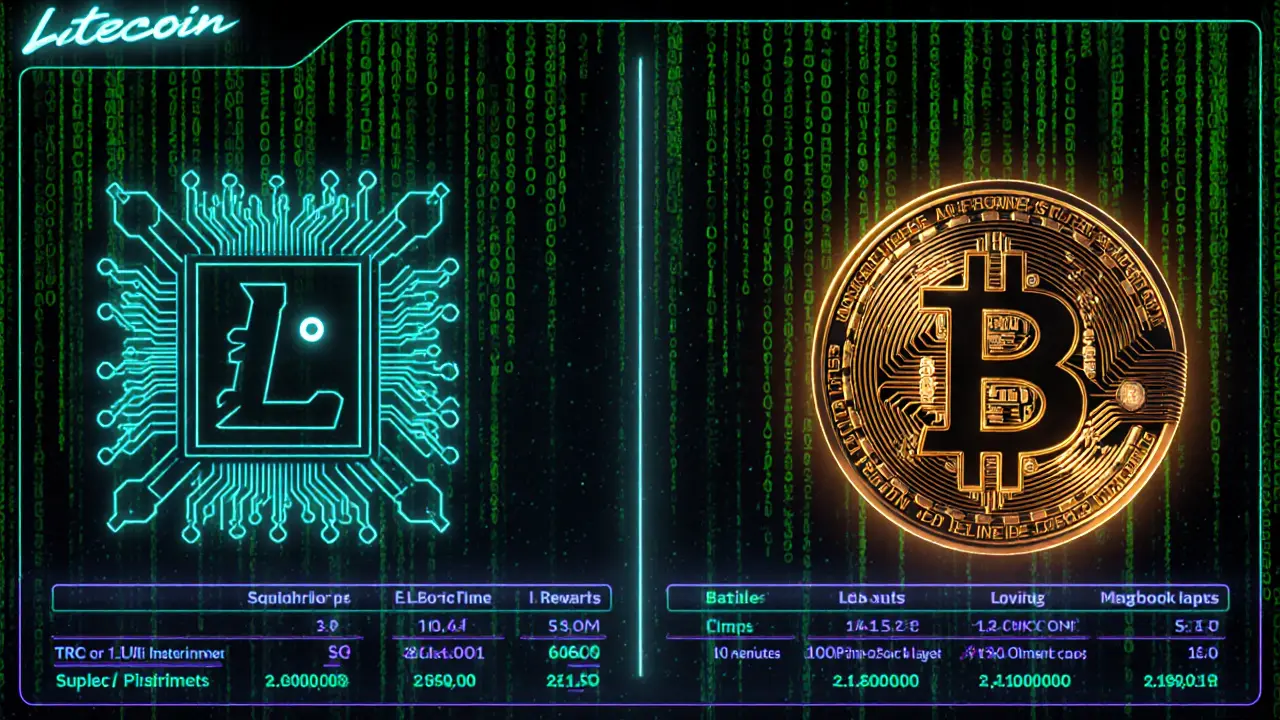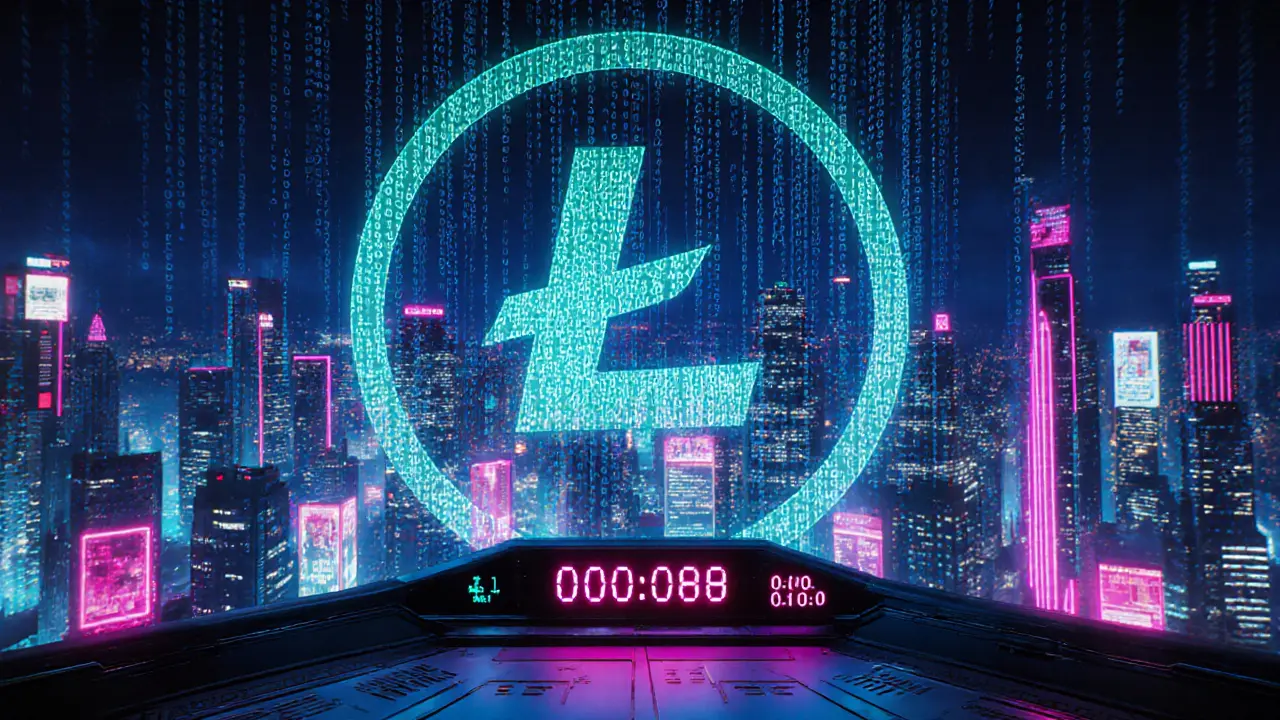Litecoin Halving Calculator
Halving Information
Enter values and click "Calculate Halving Details" to see the breakdown.
Every four years the crypto world watches a countdown that isn’t about a new app or a celebrity tweet - it’s about a built‑in supply cut called a Litecoin halving. When the reward miners earn for each block drops by 50%, the economics of the entire network shift. Understanding what happens during a Litecoin halving, how it stacks up against Bitcoin’s similar event, and why the ripple effects matter for anyone holding or mining crypto can turn a confusing buzzword into a strategic advantage.
What a Halving Actually Is
In plain terms, a Halving is a protocol‑level rule that halves the block reward after a set number of blocks are mined. The rule is hard‑coded into the blockchain’s code, so no authority can change it on a whim. For Litecoin the trigger point is every 840,000 blocks - roughly four years because Litecoin’s block time is 2.5 minutes, compared with Bitcoin’s 10‑minute cadence.
Litecoin’s Halving Timeline
Litecoin launched in 2011 with a 50LTC reward per block. The schedule looks like this:
- 2015‑08‑25: reward drops to 25LTC (first halving)
- 2019‑08‑05: reward drops to 12.5LTC (second halving)
- 2023‑08‑02: reward drops to 6.25LTC (third halving)
- ~2027: expected fourth halving to 3.125LTC
Each event squeezes roughly 1% of the total 84million LTC supply, nudging the network closer to its ultimate cap around the year 2142.
How Litecoin’s Halving Differs from Bitcoin’s
| Feature | Litecoin | Bitcoin |
|---|---|---|
| Algorithm | Scrypt | SHA‑256 |
| Block time | 2.5 minutes | 10 minutes |
| Blocks per halving | 840,000 | 210,000 |
| Initial reward | 50LTC | 50BTC |
| Current reward (2025) | 6.25LTC | 6.25BTC |
| Total supply cap | 84million LTC | 21million BTC |
The faster block time means Litecoin reaches its halving milestones sooner in calendar years, but both coins follow the same economic principle: reduce new supply, increase scarcity, and (ideally) boost price.
Why Halvings Matter for Miners
Mining under a Proof‑of‑Work model involves solving cryptographic puzzles and securing the network. Rewards consist of newly minted coins plus transaction fees. When the block reward halves, the same amount of computational work yields half the new LTC. That directly cuts profitability unless the coin’s market price rises enough to offset the loss.
Small‑scale miners often feel the squeeze first. They may lack the capital to upgrade to more efficient ASICs or GPUs, so many exit after a halving, leaving the hash rate concentrated among larger farms. While the short‑term hash‑rate dip can raise concerns about security, the remaining miners tend to be more dedicated, which can actually improve network resilience.

Price Dynamics: Theory vs. Reality
Economic theory suggests that cutting supply while demand stays constant should push prices up. In practice, the crypto market reacts to a mix of factors: investor sentiment, macro‑economic trends, and media hype. Studies from TokenMetrics and BitPay show a pattern where price often spikes in the weeks after a halving, but the magnitude varies wildly. For Litecoin:
- 2015 halving: price rose ~30% over three months.
- 2019 halving: price dipped 15% before climbing 50% a year later.
- 2023 halving: price held steady for a month, then rallied 40% amid broader bull market conditions.
These mixed outcomes highlight that halving is just one piece of the puzzle. Traders who rely solely on the “halving‑boost” risk missing the bigger picture.
How Investors Can Use Halving Data
For retail investors, a halving can serve as a calendar event to schedule portfolio reviews. Here are three practical steps:
- Track the network hash rate leading up to the event. A rising hash rate often signals miner confidence, which can be a bullish sign.
- Model profitability scenarios using current electricity costs, hardware efficiency, and the upcoming reward level. Spreadsheet calculators from the Litecoin community make this quick.
- Set price alerts at key support levels (e.g., 0.5×pre‑halving price). If the market dips sharply, you might accumulate at a discount before the scarcity effect plays out.
Remember, no model can predict sentiment‑driven swings, so keep position sizes modest and diversify across other assets.
Other Major Crypto Halvings to Watch
Litecoin isn’t alone. Several other coins embed halving or similar supply‑reduction mechanisms:
- Bitcoin - every 210,000 blocks, next expected in 2024.
- Bitcoin Cash - halving every 210,000 blocks, aligned with Bitcoin’s schedule.
- Dash - uses a “budget‑based” reduction rather than a strict halving, but still cuts supply roughly every 210,240 blocks.
- Bitcoin SV - follows Bitcoin’s halving cadence.
Each of these follows the same supply‑control logic: fewer new coins over time, higher scarcity, and a potential price premium if demand holds. However, network effects, adoption rates, and algorithm differences create distinct risk profiles.
Preparing for the Next Litecoin Halving (≈2027)
Looking ahead, the fourth Litecoin halving is slated for around mid‑2027. Here’s a checklist to stay ready:
- Hardware audit: Ensure your mining rigs can remain profitable at 3.125LTC reward. Upgrading to newer Scrypt‑optimized ASICs may be necessary.
- Energy pricing: Lock in lower electricity rates where possible - many miners negotiate contracts three years ahead.
- Liquidity plan: Decide whether you’ll hold mined LTC or convert a portion to stablecoins to cover operational costs.
- Community monitoring: Follow official Litecoin forums and GitHub releases for any protocol tweaks that could affect reward timing.
By treating the halving as a predictable calendar event rather than a mystery, you give yourself time to adjust strategy, cut costs, and possibly capitalize on the post‑halving price move.
Common Misconceptions About Halvings
1️⃣ *Halving guarantees a price surge.* - False. Supply reduction is a factor, not a certainty. 2️⃣ *Mining becomes unprofitable for everyone.* - Not always. Efficient miners with cheap power may still see healthy margins. 3️⃣ *Halving only affects miners.* - Wrong. Investors, traders, and even developers feel the ripple because market sentiment often rides the news cycle.
Understanding the nuance helps you avoid panic‑selling or over‑leveraging based on hype.

Frequently Asked Questions
What exactly triggers a Litecoin halving?
The trigger is the mining of the 840,000th block after the previous halving. Once that block is confirmed, the protocol automatically cuts the block reward from its current value to half that amount.
How does a halving impact the total supply of Litecoin?
Each halving reduces the rate at which new LTC enters circulation, stretching the time needed to reach the 84million cap. Over the life of the network, about 1% of the total supply is released per halving event.
Will my existing mining hardware become useless after a halving?
Not automatically. Profitability drops, so you’ll need to recalculate earnings based on current LTC price, power costs, and hardware efficiency. Some older rigs may still break even if electricity is cheap.
How should investors position themselves before a halving?
Consider a phased approach: keep a core holding, set limit orders for additional purchases if the price dips, and avoid over‑leveraging. Monitoring hash‑rate trends and network news can give clues about upcoming sentiment shifts.
Are there any risks unique to Litecoin’s Scrypt algorithm?
Scrypt is memory‑hard, which makes it less susceptible to ASIC dominance compared to SHA‑256, but specialized Scrypt ASICs do exist. The risk is that a sudden jump in ASIC efficiency could compress the hash‑rate distribution just before a halving, intensifying profitability pressure on smaller miners.





Comments
8 Comments
Promise Usoh
The halving mechanism presents a profound shift in the supply dynamics of Litecoin, thereby influencing market sentiment.
Whilst the mathematial underpinnings are straightforward, their macroeconomic ramifications merit careful contemplation.
Tyrone Tubero
Yo, this halving thing is like the Big Bang for crypto! It’s gonna blow the roofs off the market, no joke.
Bhagwat Sen
I feel the excitement already, bros! Every time we see a halving we get that rush of adrenaline that makes the charts go wild.
mukesh chy
Oh great, another supply cut. As if we needed more drama in the price charts. Sure, let's all panic and buy more.
Laurie Kathiari
Honestly, chasing after halving hype feels like a modern form of greed worship. People should reflect on why they chase fleeting gains instead of building real value.
Jim Griffiths
Halving reduces block rewards by 50%, cutting new LTC supply. This typically leads to lower inflation and can boost price if demand stays constant.
Cynthia Rice
In the grand tapestry of finance, halving is the thread that reminds us of impermanence.
Taylor Gibbs
You got it right, but remember folks, it's also a good time to rebalance your portfolio, ya know?
Write a comment